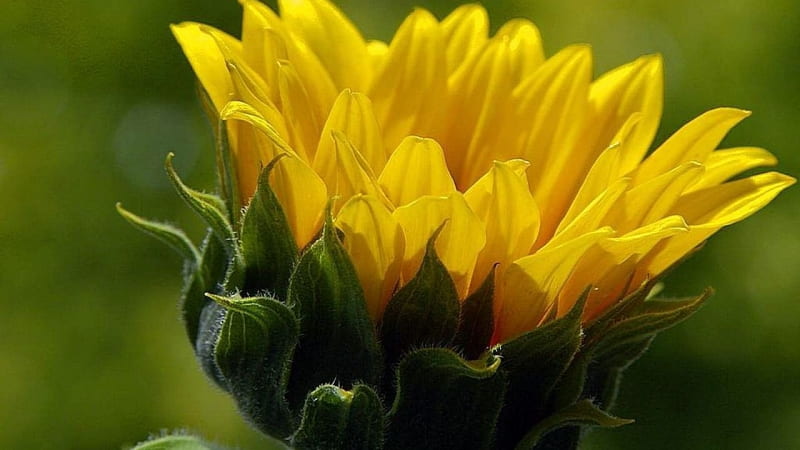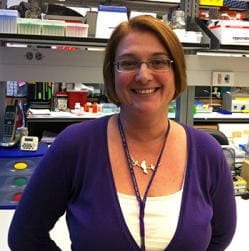THE POWER OF PHOTOSYNTHESIS
By: Bethany Hubbard

Plants are all around us. It is easy to become accustomed to their presence. But, imagine a world without lush green grasses and trees – a planet blanketed in desert. Could we survive? Plants are an integral part of our environment, and provide the food, oxygen and fibers we depend on for survival. And their ability to photosynthesize is one of nature’s most amazing and essential phenomenons.
This is something Alessia Para Gallio, research assistant professor at Northwestern and at the Chicago Botanic Garden, knows well. She completed her master’s degree in Biological Science at the University of Pavia, Italy, and received her Ph.D. degree in Physiological Botany from Uppsala University, Sweden, with a thesis on plant development. Her current research interests include the circadian clock and mineral nutrition in plants.
Science in Society spoke with Para Gallio about the importance of photosynthesis, and the role it plays in her research.
On a basic level, what is photosynthesis?
Photosynthesis is the process by which light energy from the sun is absorbed and converted into organic compounds. Organic compounds are basically different forms of sugar. They are metabolized and then energy is extracted from them. And these forms of energy can then be used by biological systems like us, for example, and animals in general.
 What happens when pigments absorb the sunlight?
What happens when pigments absorb the sunlight?
Pigments are special molecules that are involved in harvesting light from the sun. When you shine light on a pigment, the absorption of photons can energize electrons and make them move from a low to a higher energy state. To return to the low energy state, energy is quickly given off as heat, light, phosphorescence or, in the care of photosynthetic pigments, it can be transferred to another pigment molecule like chlorophyll.
What role does chlorophyll play?
Chlorophyll is probably the most important light-absorbing pigment, not only in plants, but also in algae and bacteria. When chlorophyll gets excited, it releases an electron to an electron acceptor, initiating an electron transport chain. This means that electrons are transferred from donor (reductant) to acceptor (oxidant), which has a slightly lower energy level.
During the electron transfer, protons (i.e. hydrogen ions) are pumped across the membrane of chloroplasts, the specialized organelles where photosynthesis takes place. Therefore, chloroplasts work as little batteries, with a different potential on each side, and this difference is used to create energy.
Why is photosynthesis important? What would happen if we didn’t have it?
Plants, algae and bacteria are the only organisms that can harvest sunlight and use the energy to convert CO2 (carbon dioxide) to organic material. Carbon dioxide is one of the major air pollutants, so photosynthetic organisms are actually keeping the air clean. In the process, they produce oxygen, which constitutes a significant portion of the air we breathe so less plants means less recycling of carbon dioxide and less oxygen production. Plants also give us food and fibers to make clothes and without photosynthesis, we would not be able to sustain the life we are living.
What role does photosynthesis play in your research?
I’m interested in two main topics. One is plant mineral nutrition in general and nitrogen in particular. Nitrogen metabolism is tightly linked to photosynthesis because one of the products of the assimilation of nitrogen, glutamate, is the source of chlorophyll. And the sugars that are produced by photosynthesis are used to make glutamate and other amino acids.
One of the first signs of nitrogen deficiency is chlorosis, a condition in which leaves turn yellow because there is not enough nitrogen to make glutamate. Hence, there is not enough chlorophyll.
The other topic I’m very interested in is plant circadian clocks, and the way the circadian clock regulates many different aspects of plant development and metabolism.
And one of the processes that is under very tight circadian regulation is photosynthesis. What the circadian clock does is to prepare the organism for whatever is coming next. So, before dawn, all the genes that are required for photosynthesis are turned on so as soon as there is light (sunrise) the process is ready to start. So, there is no lag time between when the sun comes up and when plants are ready to use the light from it.
Similarly, before we wake up, we need our adrenaline to go up, and the levels of some hormones to change, and sugars to get into circulation. So when the alarm clock goes off we are ready to go. And some studies suggest that without circadian clock we would have a heart attack every time we wake up because we would not be ready for it.
So that’s the advantage of having a circadian clock. You are ready for whatever is coming next, if whatever is coming next is happening every day.
So, plants and humans have a similar circadian clock?
Yes, the molecular architecture is different but the function is the same, that is to adapt to a life on a planet that has a 24-hour rotation period, and cycles of light and dark that alternate.
How does the weather affect photosynthesis?
Photosynthesis is very sensitive to light intensity. So, in general, the system shuts down at noon, or at the peak of the hottest hours of the day, because too much energy from the sun can damage biological structure. So, it will cause a lot of electrons to go around and they then become very poisonous to biological structures. So they want to make sure that they use a light intensity that is suitable. And when it’s just too much the system shuts down.
In the winter, when there aren’t leaves on the trees, what happens to our oxygen supply?
I don’t believe that we breathe only the oxygen that is produced where we live. For example, the Amazon is producing a lot of oxygen and eventually it gets to us as well. So, we are not dependent only on the plants that are around us. We are dependent on the amount of plants on the planet, on earth.
Have scientists come up with a way to replicate the process of photosynthesis?
It has been a challenge for many years, and many labs have taken this challenge up. But, recently, there was a group at the Royal Institute of Technology in Stockholm that managed to produce a catalyst that is able to use sunlight to split water into oxygen as photosynthesis does.
The importance of this discovery is not only related to oxygen. When you split water there is also the production of hydrogen, and this is really important for the urgency that we have to find alternatives sources of renewable energy.
So, if they get this to work correctly, they could use it to produce renewable energy?
Yes. The most important thing is that the initial source of these hydrogen ions is the sun, which is infinite.
Photosynthesis is one of the great inventions of nature that we are trying first to understand, and then somehow to replicate. But, most of the time we manage to understand it, but replicating it is kind of difficult.
